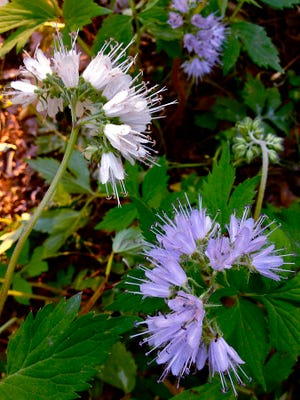Virginia waterleaf shows soft, beautiful colors in spring

Editor’s note: Once a month OSU Extension Master Gardener Volunteers in Franklin County profile a plant that occurs naturally in central Ohio.
Hydrophyllum virginianum (also known as Virginia waterleaf, Eastern waterleaf, John’s cabbage and Shawnee salad) is an herbaceous woodland perennial from the waterleaf family that has much to offer the central-Ohio home gardener throughout the growing season.
Native to the moist woodlands of both the United States and eastern Canada, the first leaves of the Virginia waterleaf to emerge in early spring have a lovely, mottled white pattern that looks as if they have water droplets on them.
More:Showy and fragrant Dutchman's breeches a delightful native plant blooming March to May
The plant’s genus name comes from the Greek hydro (water) and phyllon (leaf) highlighting this distinct characteristic. Leaves that emerge later in the summer do not have this water-dropletpattern.
The leaves can be up to 6-inches long, are often wider than they are long and have jagged, pointy edges. From early/midspring to July, up to 20 showy and clustered bell-shaped flowers bloom at the end of erect leafless peduncles that extend above the leaves.
They vary in color from a delicate white, pink or pale blue to light purple. Each flower is 1-3 inches in size and has five hairy stamens with pale yellow tips inside.
Historically, the roots of Hydrophyllum virginianum were used to make a medicinal tea to stop bleeding, diarrhea and dysentery, as well as a treatment for cracked lips and mouth sores. The roots have also been utilized to induce vomiting.
Young leaves and shoots, however, are edible and can be tasty additions to salads. Growing 1-2 feet high and wide, the Virginia waterleaf would be a great, low-maintenance addition to wooded areas, but because it can spread rather aggressively, it may not be a good choice for a small garden.
The flowers are of special value to bees, including bumble, yellow-faced, Andrenid, sweat, small carpenter and other long-tongued bees. They are particularly invaluable to the native waterleaf cuckoo bee, which only feeds on plants in the genus Hydrophyllum.
Growing conditions
Hardiness zones: 4A-8B
Sun: Partial sun to shade
Water: Consistently moist, can tolerate wet
Soil: Prefers rich, well-drained soil
Maintenance: Low
Propagation: Division of rhizome in the fall when plant is dormant. Each division shouldhave a leaf bud and some roots.
Pests and diseases: No significant diseases or insect pests. Deer may occasionally eatthe foliage.